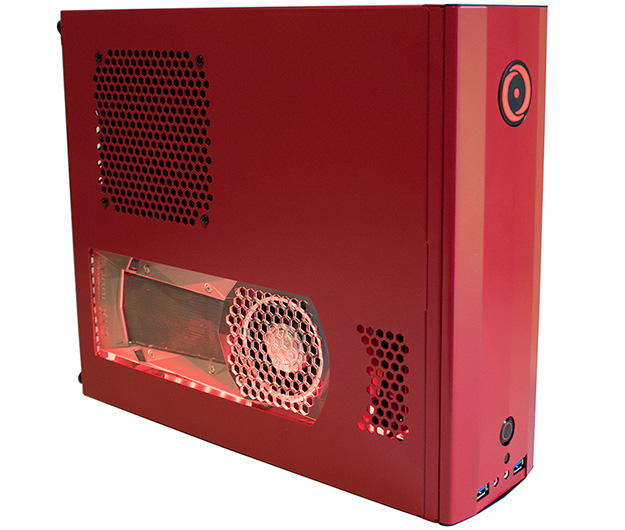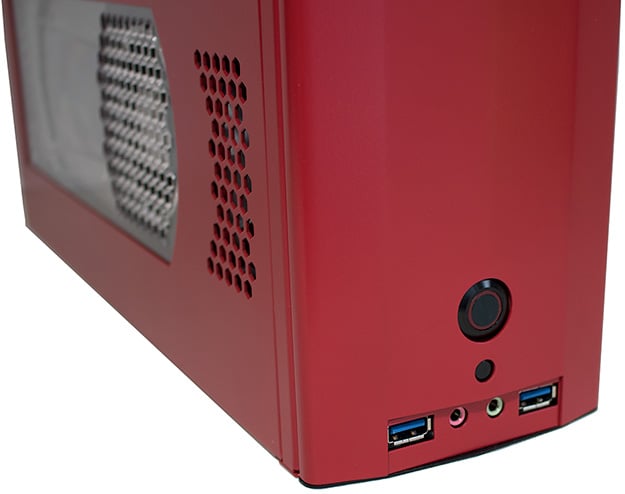Origin PC Chronos Review: A Powerful Small Form Factor Desktop PC For 4K Gaming
Origin PC Chronos: Design And Build Quality
The Chronos is offered with two flavors of Intel platforms—H270/Z70 starting at $1,177 and X99 starting at $1,674. Okay, that's technically three flavors of Intel chipsets, though Origin PC lumps the H270 and Z270 options into a single category. Configuring a Chronos around AMD's AM4 platform is not yet an option, though we suspect it is only a matter of time before Origin PC welcomes Ryzen to the fray.
One advantage to selecting a Chronos system is the opportunity to own something wholly unique compared to what you can build yourself. Sure, the components inside are parts that have been plucked right off the shelf—and that's a good thing—the small form factor chassis is Origin PC's own custom design, however. It's a spiffy looking enclosure made of steel that can stand vertical, as shown above, or lay down horizontally like this:
Either way, the Chronos does not take up much physical space. The compact chassis measures 11.75 inches high by 4 inches wide and 13.75 inches deep. There is no right or wrong way to orient the Chronos—it can stand vertical with the front I/O ports situated at the top or bottom, or rest on either side on an A/V rack inside your entertainment center. Origin PC includes four rubber feet that magnetically attach to the case, both to prevent it from sliding around and to create a gap for air to flow between the surface and whichever end serves as the base.
It is a clever design that affords users flexibility in placing the Chronos wherever it will be best utilized, whether that is next to a monitor on a desktop or sitting adjacent to an Xbox One console in the living room. Once you've settled on an orientation, you can rotate the backlit Origin PC logo on the front so that the Chronos looks like it was designed to sit whichever way you have it.
Every Chronos PC comes with two USB 3.0 ports and individual headphone and microphone jacks on the front. There is also a power button and reset button that sit just above. As for rear connectivity, that depends on which motherboard and graphics card combination you select. With the MSI Z270 Gaming Pro Carbon AC that is installed in our review system, we have access to enough USB 3.1 and 3.0 ports to run a VR headset. We also like that it comes with integrated 802.11ac Wi-Fi connectivity, as running an Ethernet cable to a system's LAN port is not always convenient.
The assembly inside the Chronos is both tight and clean. Given the case's compact size, the Chronos expertly makes use of just about every inch of real estate, yet somehow manages to keep things tidy with excess cabling tucked out of the way. This is not matter of installing parts and simple shoving cables to the side—the builders at Origin PC obviously spent a fair amount of time routing wires in a specific way and using zip ties where needed.
Liquid cooling comes standard on every Chronos. With only a few inches of clearance, there just is not room to install a bulky air cooler. Self-contained liquid coolers are all the rage these days anyway, though the trade off is that the 120mm radiator and fan have to be installed on the side panel. That prevents you from being able to toss the side panel aside when opening the case, though if you really need the added elbow space, you can unscrew the radiator from the side panel while you perform upgrade surgery.
This is an acceptable trade off to us, both because it does not really interfere with being able to upgrade and swap out components, and due to the added cooling prowess of an AIO liquid cooler. In this instance, Origin PC was able to overclock the Core i7-7700K from 4.2GHz to 4.8GHz, which proved stabled in our testing.
Origin PC uses a PCIe riser cable in order to install the graphics card sideways inside the Chronos. This is mainly to make room for full size graphic card options, but there is also a transparent side window that shows off the GPU. Optional LED lighting (red in this case) adds to the effect and turns an already attractive setup into a show worthy system.
It is pretty amazing to think that a top tier graphic card can squeeze into such a tight space, and the Chronos is proof that it can be done without any ill effects, such as overheating. If you really want to, you can select up to a Titan Xp, though the GeForce GTX 1080 Ti used here is a much better value—it offers near the same performance at around half the price.
A 4TB mechanical hard drive is nestled underneath the graphics card. As it's only a backup storage drive and not the primary storage, we're not too worried about heat from the backside of the GPU getting in the way of its operation.
One advantage to selecting a Chronos system is the opportunity to own something wholly unique compared to what you can build yourself. Sure, the components inside are parts that have been plucked right off the shelf—and that's a good thing—the small form factor chassis is Origin PC's own custom design, however. It's a spiffy looking enclosure made of steel that can stand vertical, as shown above, or lay down horizontally like this:
Either way, the Chronos does not take up much physical space. The compact chassis measures 11.75 inches high by 4 inches wide and 13.75 inches deep. There is no right or wrong way to orient the Chronos—it can stand vertical with the front I/O ports situated at the top or bottom, or rest on either side on an A/V rack inside your entertainment center. Origin PC includes four rubber feet that magnetically attach to the case, both to prevent it from sliding around and to create a gap for air to flow between the surface and whichever end serves as the base.
It is a clever design that affords users flexibility in placing the Chronos wherever it will be best utilized, whether that is next to a monitor on a desktop or sitting adjacent to an Xbox One console in the living room. Once you've settled on an orientation, you can rotate the backlit Origin PC logo on the front so that the Chronos looks like it was designed to sit whichever way you have it.
Every Chronos PC comes with two USB 3.0 ports and individual headphone and microphone jacks on the front. There is also a power button and reset button that sit just above. As for rear connectivity, that depends on which motherboard and graphics card combination you select. With the MSI Z270 Gaming Pro Carbon AC that is installed in our review system, we have access to enough USB 3.1 and 3.0 ports to run a VR headset. We also like that it comes with integrated 802.11ac Wi-Fi connectivity, as running an Ethernet cable to a system's LAN port is not always convenient.
The assembly inside the Chronos is both tight and clean. Given the case's compact size, the Chronos expertly makes use of just about every inch of real estate, yet somehow manages to keep things tidy with excess cabling tucked out of the way. This is not matter of installing parts and simple shoving cables to the side—the builders at Origin PC obviously spent a fair amount of time routing wires in a specific way and using zip ties where needed.
Liquid cooling comes standard on every Chronos. With only a few inches of clearance, there just is not room to install a bulky air cooler. Self-contained liquid coolers are all the rage these days anyway, though the trade off is that the 120mm radiator and fan have to be installed on the side panel. That prevents you from being able to toss the side panel aside when opening the case, though if you really need the added elbow space, you can unscrew the radiator from the side panel while you perform upgrade surgery.
This is an acceptable trade off to us, both because it does not really interfere with being able to upgrade and swap out components, and due to the added cooling prowess of an AIO liquid cooler. In this instance, Origin PC was able to overclock the Core i7-7700K from 4.2GHz to 4.8GHz, which proved stabled in our testing.
Origin PC uses a PCIe riser cable in order to install the graphics card sideways inside the Chronos. This is mainly to make room for full size graphic card options, but there is also a transparent side window that shows off the GPU. Optional LED lighting (red in this case) adds to the effect and turns an already attractive setup into a show worthy system.
It is pretty amazing to think that a top tier graphic card can squeeze into such a tight space, and the Chronos is proof that it can be done without any ill effects, such as overheating. If you really want to, you can select up to a Titan Xp, though the GeForce GTX 1080 Ti used here is a much better value—it offers near the same performance at around half the price.
A 4TB mechanical hard drive is nestled underneath the graphics card. As it's only a backup storage drive and not the primary storage, we're not too worried about heat from the backside of the GPU getting in the way of its operation.












